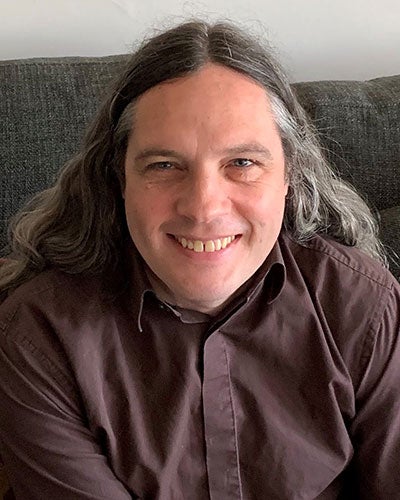Exploring Deep Questions at the Intersection of Philosophy and Physics
 “Philosophy and physics have a long shared history,” explains David Wallace, W.A. Mellon Professor of Philosophy of Science. Wallace holds joint appointments in the Dietrich School’s Departments of Philosophy and History and Philosophy of Science and spends his time investigating philosophical questions about how we understand physics.
“Philosophy and physics have a long shared history,” explains David Wallace, W.A. Mellon Professor of Philosophy of Science. Wallace holds joint appointments in the Dietrich School’s Departments of Philosophy and History and Philosophy of Science and spends his time investigating philosophical questions about how we understand physics.
According to Wallace, much of his work examines conceptual physics questions that are implicit in the way deep thinkers in physics develop their subject. Wallace works to make these questions more explicit and more widely accessible.
“My work is mostly interdisciplinary,” says Wallace. “I'm exploring conceptual questions that can't really be understood—let alone answered—without a serious understanding of the physics, but which are a bit removed from the more practical, calculational/experimental work that is the bread and butter of physics, and which are sometimes informed by deep ideas that come from philosophy proper.”
Wallace became interested in physics as a young college student by way of popular science books including "A Brief History of Time" by Steven Hawking and "The Starflight Handbook" by Eugene Mallove and Gregory Matloff. "The Starflight Handbook" was particularly alluring because it provided mathematical equations to explain the ideas it discussed.
“Once I understood that you could actually calculate these things quantitatively, I was hooked and wanted to know more,” remembers Wallace.
In graduate school, Wallace found himself drawn to more conceptual physics questions, such as how to understand quantum mechanics and what physicists mean by "particle" when discussing particle physics. At the time, he was studying at Oxford, which had a world-class research group studying the philosophy of physics.
“I'd been hanging out with them for a while anyway and it was easy to move sideways,” says Wallace.
Now, as a professor, Wallace has performed impactful research in theoretical physics, notably on the Everett (many-worlds) interpretation of quantum mechanics. Wallace said that in quantum mechanics, macroscopic objects can simultaneously have incompatible properties, such as Schrodinger’s cat, which can be alive and dead at the same time.
“The standard response to that is that it's impossible for cats to be alive and dead at the same time, so something must be wrong—or at any rate incomplete—about the theory,” says Wallace. “Everett asked, in effect, `What if the cat actually was alive and dead at the same time?’ And the answer (apparently, and so I've argued) is that this amounts to the world (or at least our local neighborhood) splitting in two—a world where the cat lives, and a world where it dies. Weird though that sounds, I think it's probably the right way to understand quantum mechanics—not least because it doesn't require us to change the theory, only to understand it in a surprising way.”
Complex questions such as this drive Wallace’s research program. Right now, Wallace is focused on several other intriguing projects, including how to think about the difference between the past and the future.
“At the microscopic level, physics doesn't seem to care which is which. But, of course, we care and so does physics at the large scale (for instance, the ice in my glass melts but doesn't refreeze; fires burn and don't un-burn),” Wallace offers.
In addition to his thought-provoking research, Wallace helps his students understand scientific processes and how to appreciate important fundamental properties of the nature of research.
“I want to give people a sense of what science is like as a process—fallible, flawed, but still remarkable,” says Wallace. “A big problem with public perception of science is that it gives the impression that science is an oracle that makes infallible pronouncements - and then when those pronouncements turn out to be fallible after all, people can start to be skeptical about science as a whole. … Science isn't really like that at all. Of course, what it is like is controversial.”
In addition to helping students understand the nuances of scientific research, he wants his students to appreciate that the scientific method is not a simple or uncontentious process.
“Philosophy has a role to play in helping scientists do better science,” says Wallace, who helps students understand this point by helping them think more clearly and more critically about aspects of scientific methodology that they may take for granted.
In the course Philosophy of Physics, Wallace also helps his students, those trained in philosophy and those trained in physics, understand research questions on a level that allows them to appreciate conceptual ideas. This can be challenging because understanding physics research literature almost requires a graduate degree.
“I think of this kind of class as serving both physicists who are curious about the conceptual issues that get glossed over in other classes, and philosophers who might be interested in how physics can inform, and sometimes transform, core philosophical questions,” says Wallace. “My goal is to get students to see the core conceptual issues—which usually can be understood without technical details—so they can see why they're so important and contested, and maybe get excited about learning more.”
According to Wallace, Pitt is a wonderful home base for performing research that combines philosophy and physics.
“Pitt is probably the best place in the world to do philosophy of science. Or, more accurately, Pitt's HPS department is one of the best places in the world, and Pitt's philosophy department is also one of the best places in the world—having them on adjacent floors is amazing.” Adds Wallace, “This is somewhere where I can have multiple colleagues, and multiple students, whose active focus is philosophy of physics, as well as many more colleagues and students who are interested in somewhat-related areas—whether that's history of physics, or foundations of mathematics, or emergence in science, or metaphysics.”
